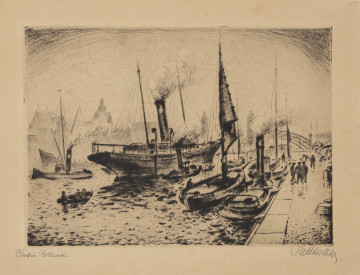
View of Long Bridge
połowa XIX wieku
National Museum in Szczecin
Part of the collection: Iconography of Szczecin in the 17th-19th centuries
The harbour and views of Szczecin along the Oder were a popular painting theme in the second half of the 19th century. However, some of the iconographies were characterised by a tendency to idealise reality. Works of this type, in the form of illustrations, were used in advertising or commemorative publications. Other works were characterised by a detailed and realistic depiction of Szczecin's waterfront without embellishing or glorifying it. The coloured woodcut by Gustav Schönleber (1851-1917) with a fragment of the development of the river island of Łasztownia (Lastadie) is an example of iconography of a utilitarian character, being an illustration for an advertising book. Schönleber was born in Württemberg and studied in Munich. He made many artistic journeys around Europe and, from 1880, worked as a professor in Karlsruhe, where he taught at the local art school. He was a well-known illustrator of architecture, marine motifs and landscape painting. One of his works depicting the Szczecin castle was included in the German novelist Edmund Hoefer (1819-1882) Küstenfahrten an der Nord- und Ostsee. A woodcut with Łasztownia appeared in a Stuttgart publication from 1881, describing journeys along the Baltic coast and the North Sea and advertising the region's attractions. Xylographic illustrations based on Schönleber's composition were made and published by Adolf Georg Closs (1840-1894), a wood engraver from Stuttgart, considered one of the best German reproduction printmakers. He ran a xylographic institute that produced illustrations for geographic and national history publications. The woodcut realistically shows the Szczecin waterfront, following the actual state in the last decades of the 19th century. At that time, Łasztownia was not very representative, but it allowed for the demonstration of artistry in the art of woodcut.
Małgorzata Peszko
Author / creator
Dimensions
cały obiekt: height: 26,8 cm, width: 36,5 cm
Creation time / dating
Creation / finding place
Identification number
Location / status

połowa XIX wieku
National Museum in Szczecin

1920 — 1935
National Museum in Szczecin

1875 — 1899
National Museum in Szczecin
DISCOVER this TOPIC
National Museum in Lublin
DISCOVER this PATH
Educational path